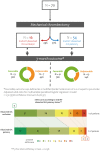Internal carotid artery patency after mechanical thrombectomy for stroke due to occlusive dissection: Impact on outcome
- PMID: 37021179
- PMCID: PMC10069197
- DOI: 10.1177/23969873221140649
Internal carotid artery patency after mechanical thrombectomy for stroke due to occlusive dissection: Impact on outcome
Abstract
Introduction: Internal carotid artery dissection (ICAD) is a rare cause of acute ischemic stroke with large vessel occlusion (AIS-LVO). We aimed investigating the impact on outcome of internal carotid artery (ICA) patency after mechanical thrombectomy (MT) for AIS-LVO due to occlusive ICAD.
Patients and methods: We included consecutive patients with AIS-LVO due to occlusive ICAD treated with MT from January 2015 to December 2020 in three European stroke centers. We excluded patients with unsuccessful intracranial reperfusion after MT (modified Thrombolysis in Cerebral Infarction (mTICI) score < 2b). We compared 3-month favorable clinical outcome rate, defined as a modified Rankin scale (mRS) score ⩽2, according to ICA status (patency vs occlusion) at the end of MT and at 24-h follow-up imaging, using univariate and multivariable models.
Results: Among 70 included patients, ICA was patent in 54/70 (77%) at the end of MT, and in 36/66 (54.5%) patients with 24-h follow-up imaging. Among patients with ICA patency at the end of MT, 32% presented ICA occlusion at 24-h control imaging. Favorable 3-month outcome occurred in 41/54 (76%) patients with ICA patency post-MT and in 9/16 (56%) patients with occluded ICA post-MT (p = 0.21). Rates of favorable outcome were significantly higher in patients with 24-h ICA patency compared to patients with 24-h ICA occlusion (32/36 [89%] vs 15/30 [50%]), with an adjusted odds ratio of 4.67 (95% CI: 1.26-17.25).
Discussion and conclusion: Obtaining sustained (24-h) ICA patency after MT could be a therapeutic target for improving functional outcome in patients with AIS-LVO due to ICAD.
Keywords: Stroke; carotid dissection; internal carotid artery; large vessel occlusion; mechanical thrombectomy.
© European Stroke Organisation 2022.
Conflict of interest statement
The author(s) declared no potential conflicts of interest with respect to the research, authorship, and/or publication of this article.
Figures




Similar articles
-
Impact of Patency of the Carotid Terminus and Middle Cerebral Artery on Early Clinical Outcomes in Patients with Acute Internal Carotid Artery Occlusion and Mild Symptoms.Cerebrovasc Dis Extra. 2023;13(1):1-8. doi: 10.1159/000527635. Epub 2022 Oct 24. Cerebrovasc Dis Extra. 2023. PMID: 36279847 Free PMC article.
-
Revascularization of carotid artery occlusion using stenting versus non stenting in endovascular management of tandem occlusion stroke.J Clin Neurosci. 2022 Apr;98:15-20. doi: 10.1016/j.jocn.2022.01.036. Epub 2022 Feb 4. J Clin Neurosci. 2022. PMID: 35131720 Review.
-
Impact of Day 1 carotid patency on outcome in dissection-related tandem occlusions treated with mechanical thrombectomy.J Neuroradiol. 2024 Mar;51(2):196-203. doi: 10.1016/j.neurad.2024.01.076. Epub 2024 Feb 1. J Neuroradiol. 2024. PMID: 38309578
-
Safety and outcome of mechanical thrombectomy in ischaemic stroke related to carotid artery dissection.J Neurol. 2022 Feb;269(2):772-779. doi: 10.1007/s00415-021-10656-w. Epub 2021 Jun 29. J Neurol. 2022. PMID: 34184125
-
Mechanical thrombectomy with Solitaire stent for acute internal carotid artery occlusion without atherosclerotic stenosis: dissection or cardiogenic thromboembolism.Eur Rev Med Pharmacol Sci. 2014;18(9):1324-32. Eur Rev Med Pharmacol Sci. 2014. PMID: 24867510 Review.
Cited by
-
Deep Learning-Based ASPECTS Algorithm Enhances Reader Performance and Reduces Interpretation Time.AJNR Am J Neuroradiol. 2025 Mar 4;46(3):544-551. doi: 10.3174/ajnr.A8491. AJNR Am J Neuroradiol. 2025. PMID: 39255988
-
Predicting vessel recanalization in extracranial internal carotid artery dissection: a nomogram based on ultrasonography and clinical features.Front Neurol. 2025 Apr 7;16:1498182. doi: 10.3389/fneur.2025.1498182. eCollection 2025. Front Neurol. 2025. PMID: 40260137 Free PMC article.
-
Carotid artery dissection recanalization: imaging modalities, influencing factors, and therapeutic perspectives.Front Neurol. 2025 Jul 8;16:1624698. doi: 10.3389/fneur.2025.1624698. eCollection 2025. Front Neurol. 2025. PMID: 40697575 Free PMC article. Review.
-
Emergency endovascular treatment of stroke due to cervical artery dissection - impact of periprocedural GP IIb/IIIa inhibitor use on clinical outcome.CVIR Endovasc. 2025 May 22;8(1):47. doi: 10.1186/s42155-025-00564-9. CVIR Endovasc. 2025. PMID: 40402362 Free PMC article.
References
-
- Engelter ST, Rutgers MP, Hatz F, et al. Intravenous thrombolysis in stroke attributable to cervical artery dissection. Stroke 2009; 40: 3772–3776. - PubMed
-
- Leys D, Bandu L, Hénon H, et al. Clinical outcome in 287 consecutive young adults (15 to 45 years) with ischemic stroke. Neurology 2002; 59: 26–33. - PubMed
-
- Yesilot Barlas N, Putaala J, Waje-Andreassen U, et al. Etiology of first-ever ischaemic stroke in European young adults: the 15 cities young stroke study. Eur J Neurol 2013; 20: 1439. - PubMed
-
- Saver JL, Goyal M, Bonafe A, et al. Stent-retriever thrombectomy after intravenous t-PA vs. t-PA alone in stroke. New Engl J Med 2015; 372: 2285–2295. - PubMed
MeSH terms
LinkOut - more resources
Full Text Sources
Medical
Miscellaneous

